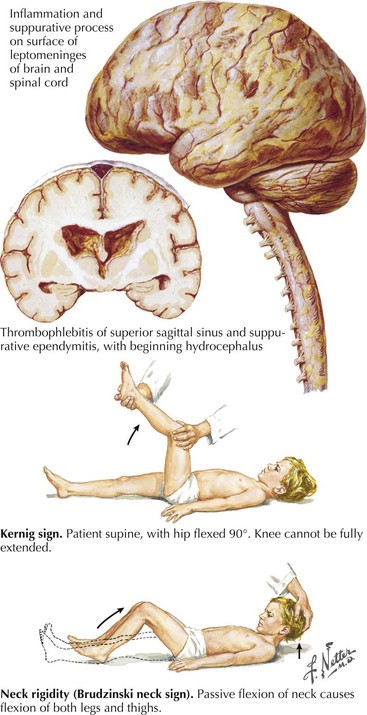
31 Bacterial meningitis can be diagnosed with more than 99% certainty in patients with any of the following CSF measurements: glucose less than 34 mg per dL (1.89 mmol per L), protein greater than 220 mg per dL (2,200 mg per L), WBCs greater than 2,000 per μL, or neutrophils greater than 1,180 per μL. 8 The ratio of CSF glucose to serum glucose can be normal to significantly decreased depending on the type of pathogen, time since infection onset, and presence of dextrose in any intravenous fluids the patient has received. Nearly all patients with bacterial meningitis have an elevated CSF protein level. PCR test preferred other tests include CSF lactate (low), Gram stain, CSF or serum immunoglobulin M antibodies for arboviruses, electroencephalography or other neuroimaging for suspected encephalitis Usually 100 to 1,000 per μL higher in patients with enterovirus infection (elevated red blood cell count possible in patients with herpes infection) Usually normal decreased in 25% of patients with mumps mild decrease possible in patients with HIV infection Lymphocyte predominance possible PMN predominance in early infection Multiple cultures with acid-fast stain PCR test (56% sensitive and 98% specific), CSF adenosine deaminase (> 10 U per L ) “pellicle” appearance of CSF ‡ Usually 5 to 300 per μL 500 to 1,000 per μL in 20% of cases Median: 40 mg per dL lower in advanced stages PCR test enzyme-linked immunosorbent assay for Angiostrongylus cantonensis, Gnathostoma spinigerum, and Baylisascaris procyonisĮarly lymphocyte and PMN predominance progressing to lymphocyte predominance Variable but can be persistently elevated, requiring CSF draining HIV test, CSF Venereal Disease Research Laboratory test (30% to 75% sensitive and 100% specific †), CSF fluorescent treponemal antibody absorption test (100% sensitive and 50% to 70% specific)Įosinophilia (> 10 eosinophils per μL or > 10% of total cells)
CSF FINDINGS IN BACTERIAL AND VIRAL MENINGITIS SERIAL
> 250 mm H 2O in severe cases serial lumbar punctures or ventriculoperitoneal shunt required to drain CSF if pressure persistently > 250 mm H 2O Gram stain, CSF culture, CSF lactate (> 35.1 mg per dL ), PCR testing latex agglutination if Gram stain is negative and antibiotics were given before lumbar puncture Usually 80% to 90% PMNs > 50% lymphocytes possible

It has a poor prognosis, and large-volume CSF cytology is diagnostic. Leptomeningeal carcinomatosis can mimic central nervous system infection. Xanthochromia and an elevated red blood cell count are characteristic CSF findings in patients with subarachnoid hemorrhage. Computed tomography of the head is nearly 100% sensitive for subarachnoid hemorrhage in the first six hours after symptom onset, but CSF analysis may be required if there is a delay in presentation or if imaging findings are equivocal. Subarachnoid hemorrhage has a high mortality rate, and rapid diagnosis is key to improve outcomes. Immunocompromised patients may have meningitis caused by tuberculosis, neurosyphilis, or fungal or parasitic infections. Adjunctive tests such as CSF lactate measurement, latex agglutination, and polymerase chain reaction testing can help differentiate between bacterial and viral causes of meningitis. Viral meningitis can present similarly to bacterial meningitis but usually has a low mortality rate.

CSF culture can identify causative organisms and antibiotic sensitivities. Bacterial meningitis has a high mortality rate and characteristic effects on CSF white blood cell counts, CSF protein levels, and the CSF:serum glucose ratio. CSF analysis is not necessarily diagnostic but can be useful in the evaluation of other neurologic conditions, such as spontaneous intracranial hypotension, idiopathic intracranial hypertension, multiple sclerosis, Guillain-Barré syndrome, and malignancy. Urgent indications for lumbar puncture include suspected central nervous system infection or subarachnoid hemorrhage. Cerebrospinal fluid (CSF) analysis is a diagnostic tool for many conditions affecting the central nervous system.


 0 kommentar(er)
0 kommentar(er)
